Scottish greenhouse gas emissions: 1990-2015
This publication provides estimates of greenhouse gas emissions in Scotland for the years 1990 to 2015.
This document is part of a collection
Section B. Results - Net Sources of Scottish Greenhouse Gas Emissions
2015 figures
Chart B1 presents the sources and sinks of Scottish Greenhouse Gas Emissions in 2015, grouped by Scottish Government sector.
Chart B1. Sources of Scottish Greenhouse Gas Emissions, 2015. Values in MtCO 2e
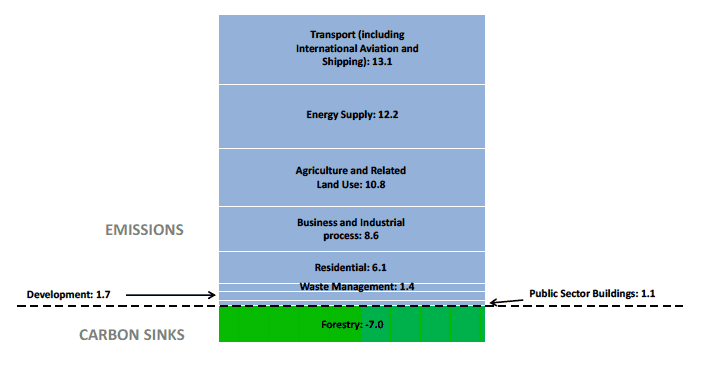
Main points
- In 2015, Transport (including International Aviation and Shipping) (13.1 MtCO 2e) was the largest source of net emissions followed by Energy Supply emissions (12.2 MtCO 2e), and Agriculture and Related Land Use emissions (10.8 MtCO 2e).
- Emissions from Business and Industrial Processes and the Residential sector were the next largest net emissions sources (8.6 MtCO 2e and 6.1 MtCO 2e respectively).
- The combined total of emissions from the other net sources (Waste Management, Development and Public Sector Buildings) was less than 5 MtCO 2e.
- Forestry was the only aggregate sector in which there has been a net emissions sink (-7.0 MtCO 2e).
Table B1. Scottish Greenhouse Gas Emissions by Gas and by Scottish Government Source Sector, 2015. Values in MtCO 2e
| TOTAL | Percentage share by sector | Carbon dioxide | Methane | Nitrous oxide | Fluorinated gases | |
|---|---|---|---|---|---|---|
| TOTAL | 48.1 | 100.0% | 36.2 | 6.7 | 3.7 | 1.4 |
| Transport (including International Aviation and Shipping) | 13.1 | 27.4% | 13.0 | 0.0 | 0.1 | 0.0 |
| Transport (excluding IA&S) | 10.8 | 22.4% | 10.7 | 0.0 | 0.1 | 0.0 |
| International Aviation and Shipping (IA&S) | 2.4 | 4.9% | 2.3 | 0.0 | 0.0 | 0.0 |
| Energy Supply | 12.2 | 25.4% | 11.7 | 0.4 | 0.1 | 0.0 |
| Agriculture and related land use | 10.8 | 22.5% | 3.0 | 4.8 | 3.0 | 0.0 |
| Business and Industrial process | 8.6 | 17.9% | 7.2 | 0.0 | 0.1 | 1.3 |
| Residential | 6.1 | 12.7% | 5.8 | 0.1 | 0.0 | 0.1 |
| Development | 1.7 | 3.6% | 1.6 | 0.0 | 0.1 | 0.0 |
| Waste Management | 1.4 | 2.9% | 0.0 | 1.3 | 0.1 | 0.0 |
| Public Sector Buildings | 1.1 | 2.2% | 1.1 | 0.0 | 0.0 | 0.0 |
| Forestry | -7.0 | -14.5% | -7.1 | 0.0 | 0.1 | 0.0 |
Main points
Carbon dioxide was the main greenhouse gas emitted or removed in most sectors, with the exceptions of the Agriculture and Related Land Use and Waste Management sectors.
- Methane was the main net gas emitted in the Agriculture and Related Land Use sector (4.8 MtCO 2e), followed by carbon dioxide (3.0 MtCO 2e) and nitrous oxide (3.0 MtCO 2e).
- Almost all emissions in the Waste Management sector were emitted in the form of methane (1.3 MtCO 2e).
Where F gases are emitted, they have been in relatively small amounts via the Business and Industrial Process source sector, as well as in the Residential sector.
Key Trends By Scottish Government Source Sector
Chart B2 presents the main sources of Scottish Greenhouse Gas Emissions in Scotland from 1990 to 2015, broken down by Scottish Government source sector. Note that for the purposes of presentation, some sectors have been grouped together on this chart. Chart B3 and Chart B4 specifically explore the trend in Energy Supply emissions. Chart B5 contains information on the absolute and percentage reductions in greenhouse gas emissions in every Scottish Government source sector over the entire time period, with Chart B6 containing the same information for the latest year.
Chart B2. Main Sources of Greenhouse Gas Emissions in Scotland, 1990 to 2015. Values in MtCO 2e
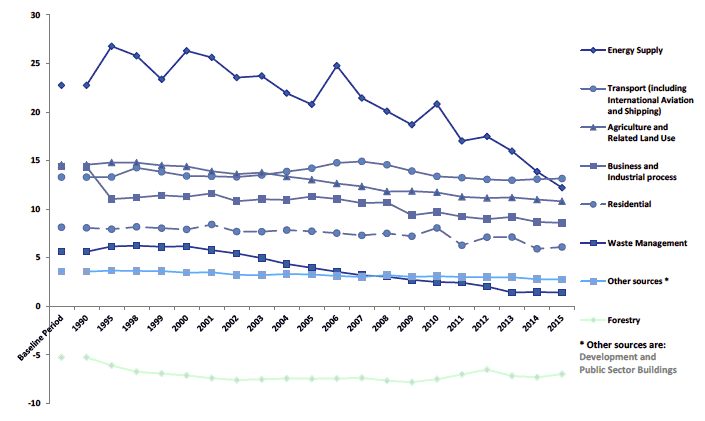
Main Points
Most sectors exhibit a general downward trend between 1990 and 2015, most clearly evident since 1998.
- From 2014 to 2015, emissions from transport (including international aviation and shipping) increased marginally by 0.4 per cent, and are now the largest single source of greenhouse gas emissions in Scotland - replacing the energy supply sector as the largest sector for the first time since the series began. Transport emissions have remained relatively steady from 1990 to 2015, and the increase in emissions in 2015 was mainly due to an increase in emissions from road transport, in particular passenger cars, light trucks, and lorries/buses.
- In 2015, the energy supply sector was the second largest source of greenhouse gas emissions, following a sharp fall in recent years. The reduction in emissions between 2014 and 2015 was driven almost entirely by a decrease in the use of coal in the power generation sector. Overall reduction in the energy sector was offset somewhat by an increase in emissions from the combustion of fuel at refineries. The chart shows that energy supply is a more volatile sector. This is driven by energy demand and ambient temperature, particularly during the winter months; and fuel used for electricity production, which in turn is partly driven by the price of coal relative to "cleaner" fuels.
- Much of the fall in emissions from the Business and Industrial Process sector occurred between 1990 and 1995. This has been driven by a decline in emissions from manufacturing and the iron and steel industry over this time period.
- Net emissions from the agriculture and related land use sector have seen a gradual decline between 1998 and 2015, which can be linked to the impact of historic changes in land use, change to cropland and grassland and also a decline in cattle and sheep numbers.
- Residential emissions have increased by 3.0 per cent between 2014 and 2015. There was a decrease from 1990 to 2015. The main driver for the increase in residential emissions is an increase in the combustion of fuel in households, dominated by an increase in natural gas use, reflecting cooler mean temperatures in 2015 compared to 2014. The fluctuation in the series in recent years is partly due to the fluctuation in demand for domestic heating.
- Methodological change to the inventory have reduced waste management emissions across the series with more significant revisions towards the beginning of the series. Waste management emissions have fallen by 74.9 per cent between 1998 and 2015. This is due to the progressive introduction of landfill gas being captured and used for energy. There could also be other factors which are contributing to this reduction such as improvements in the standards of landfill sites and changes to the types of waste going to landfill.
- Methodological change to the forestry data has reduced the sink across the whole time series. This is the single largest sectorial increase in emissions over the last year. The reduction in the carbon sink from forestry is primarily driven by the impact of the methodological changes affecting the soil carbon stocks following afforestation. In the 1990 to 2015 inventory the decrease in the sink in Scotland between 2014 and 2015 arises from the "Forest Land" category. The main source is losses from biomass carbon stock change in the "Forest Remaining Forest" category, e.g. harvesting and thinning of trees.
Chart B3 shows that the generation of Scotland's electricity changes over time. Emissions from the electricity supply sector (such as power stations) are associated with these changes.
Chart B3. Generation of Electricity by Fuel, Scotland, 2004 to 2015. Percentage of Electricity Generated by Year

Data obtained from BEIS Energy Trends, published December 2016 [5]
Main Points
- The share of Scottish electricity generation arising from the renewables sector (including hydro natural flow) has increased from 11.7 per cent in 2004 to 42.3 per cent in 2015.
- There was a drop in the proportion of electricity generation coming from gas between 2014 and 2015 (from 5.4 per cent to 3.7 per cent). This reflects the role Peterhead Power Station currently plays in the GB electricity market. This latest drop continues the decline in the share of electricity generation from gas from 2008 onwards, when it was 23.2 per cent.
- The amount of electricity generated from coal has fallen between 2014 and 2015. Overall, there has been a fall in the proportion of electricity generated from coal since 2006, although this can fluctuate from year to year.
- 34.7 per cent of Scotland's electricity supply came from nuclear energy in 2015. This represents an increase from 2007, when nuclear energy represented 25.7 per cent of Scotland's electricity supply.
Chart B4 shows the gas and coal prices for large users in the UK. The use of coal rather than gas in electricity generation can be sourced to these price effects in many cases. In 2015, the relative price of coal per kilowatt hour was slightly less than half that of gas, although it was higher than in 2014.
Chart B4. Gas and Coal Prices for Large Users in the UK (2004 to 2015) - pence per kWh

Data obtained from BEIS: Digest of UK Energy Statistics [6]
Long term (1990 to 2015) and short term (2014 to 2015) trends by sector
Chart B5 shows how emissions have changed between 1990 and 2015 in all source sectors. Chart B6 shows how emissions have changed between 2014 and 2015.
Chart B5. Change in Net Emissions by Scottish Government Sector Between 1990 and 2015 - in MtCO 2e, and percentage changes [7]

Chart B6. Change in Net Emissions by Scottish Government Sector between 2014 and 2015 - in MtCO 2e, and percentage changes [8]
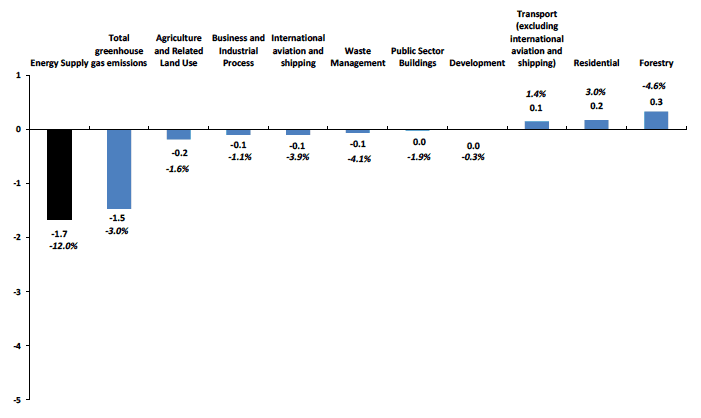
Total Emissions
Overall, there has been a 28.9 MtCO 2e (37.6 per cent) decrease in net emissions between 1990 and 2015, and there has been a 1.5 MtCO 2e (3.0 per cent) decrease in net emissions between 2014 and 2015.
Energy Supply
Energy sector emissions have decreased by 12 per cent from 2014-2015 from 13.9 MtCO 2e to 12.2 MtCO 2e, and have reduced by 46.4 per cent from 1990. Emissions reductions in this sector are mainly due to reductions in emissions from power stations.
A 21 per cent reduction in emissions from power stations between 2014 and 2015 was driven almost entirely by a decrease in the use of coal in the power generation sector.
Overall reduction in the energy sector was offset somewhat by a 14 per cent increase in emissions from the combustion of fuel at refineries.
Residential
Residential emissions have increased between 2014 and 2015 from, 5.9 MtCO 2e to 6.1 MtCO 2e (3.0 per cent). However, there has been a decrease of 24.5 per cent from 1990-2015.
The main driver for the increase in residential emissions is an increase in the combustion of fuel in households, dominated by an increase in natural gas use, reflecting cooler mean temperatures in 2015 compared to 2014 (Chart B7).
Chart B7. Mean air temperature by month, Scotland. 2014 and 2015. Values in °C
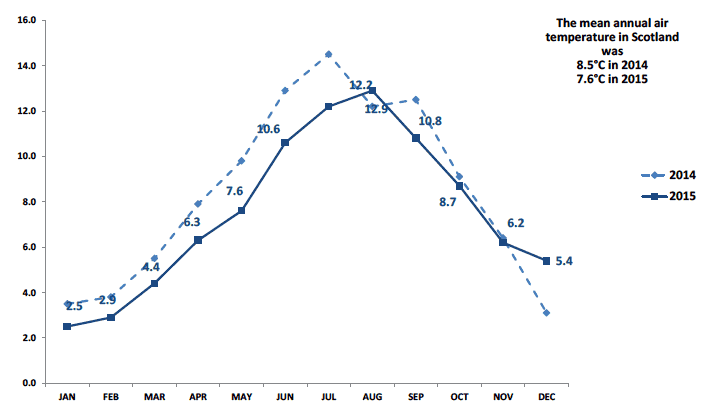
Data obtained from Met Office, May 2017 [9]
Waste Management
From 2014 to 2015 waste management decreased from 1.5 MtCO 2e to 1.4 MtCO 2e, a 4 per cent reduction.
Methodological changes to the series have reduced waste management by on average approximately 40 per cent across the series. The changes in waste management emissions between the 1990 to 2014 and 1990 to 2015 series is primarily driven by methodological changes to the Scottish waste management model, with larger revisions earlier in the series due to previous over estimation of Scotland's share of UK waste activity.
Business and Industrial Process
This sector has seen a 5.8 MtCO 2e (40.2 per cent) fall in emissions between 1990 and 2015. As shown in Chart B2, much of this decrease occurred between 1990 and 1995 - linked to a decline in emissions from manufacturing and the iron and steel industry over this time period. There has been a further smaller decrease between 2008 and 2009, coinciding with the recession. There was a decrease (0.1 MtCO 2e; 1.1 per cent) in emissions in this sector between 2014 and 2015. This has been driven by a number of factors, which include a reduction in emissions from combustion in the petrochemicals industry, and from the space heating of offices, which is partly linked to external temperatures.
Agriculture and Related Land Use
This sector has seen a 3.8 MtCO 2e (25.8 per cent) fall in net emissions between 1990 and 2015. Between 2014 and 2015, there was a 0.2 MtCO 2e (1.6 per cent) decrease in net emissions of overall greenhouse gases from this sector.
Forestry
From 2014 to 2015, the forestry sink has reduced by 4.6 per cent from -7.3 MtCO 2e to -7.0 MtCO 2e. This is the single largest sectorial increase in emissions over the last year.
Methodological changes to the series has reduced the sink by approximately 3 MtCO 2e on average (approximately 30 per cent) across the whole time series. The reduction in the carbon sink from forestry is primarily driven by the impact of the methodological changes affecting the soil carbon stocks following afforestation.
As each devolved administration has a different composition of tree species and different ratios of planting on organic and mineral soils, the changes to data and methodology have different magnitudes in each devolved administration. As Scotland has the greatest area of forestry on organic soils and this has a big influence on the differences between the 1990 to 2014 and 1990 to 2015 inventories.
In the 1990 to 2015 inventory the decrease in the sink in Scotland between 2014 and 2015 arises from the Forest Land category. The main source is losses from biomass carbon stock change in "Forest remaining Forest", e.g. harvesting and thinning of trees.
Transport (Including International Aviation and Shipping)
Transport emissions have increased by 0.4 per cent from 2014 to 2015. Transport emissions decreased by 1.1 per cent from 1990 to 2015. The increase in emissions in 2015 was mainly due to an increase in emissions from road transport, in particular passenger cars, light trucks, and lorries/buses.
Chart B2 shows that emissions rose to a peak in 2007, before falling slightly. This slight fall has been largely caused by changes in road transport emissions. Up to 2007, there was a large increase in car vehicle kilometres travelled. Since 2007 there had been a slight drop in car vehicle kilometres travelled, but in 2015 this value has returned to 2007 levels.
International aviation has increased from 1.2 MtCO 2e in 2014 to 1.3 MtCO 2e in 2015. An increase of 9 per cent from 2014 to 2015. This reflects the growth in aviation and the increase in international routes at airports. Emissions from international shipping have fallen by 48.1 per cent between 1990 and 2015 (from 2.0 MtCO 2e to 1.0 MtCO 2e). Emissions from international shipping have decreased from 2014 to 2015 (1.3 MtCO 2e to 1.0 MtCO 2e). This is primarily due to a decrease in Scotland's port freight movements.
Public Sector Buildings
This sector contributes a small proportion of Scotland's net greenhouse gas emissions. The main source of emissions from this sector is the use of natural gas for heating public buildings. There was a 0.6 MtCO 2e (37.3 per cent) fall in emissions from public sector buildings between 1990 and 2015. This has been largely driven by a reduction in the use of oil and coal for space heating. Between 2014 and 2015, there has been a 1.9 per cent fall in emissions from this sector.
Development Emissions
This sector captures net emissions from settlements and from land converted to settlements. It accounts for only a small proportion of Scotland's net greenhouse gas emissions. In 2009 there was a step change increase in development emissions ( e.g. emissions from conversion of land to settlements). The longer term trend from 1990 to 2015 shows a 10.0 per cent decrease.
The increase in emissions in the "Land Converted to Settlement" category in 2009 arises from the "Forest Land to Settlement" subcategory. For the 1990 to 2015 inventory the annual deforestation area dataset was updated using spatial data from the National Forest Inventory. In Scotland, the new dataset estimates that the rates of deforestation for Settlement purposes from 2009 to 2011 were considerably higher than the previous 3 years (2006 to 2008).
Emissions by type of gas
Chart B8 shows the trends in emissions, broken down by gas from 1990 to 2015.
Chart B8. Scottish Greenhouse Gas Emissions, by Gas, 1990-2015. Values in MtCO 2e
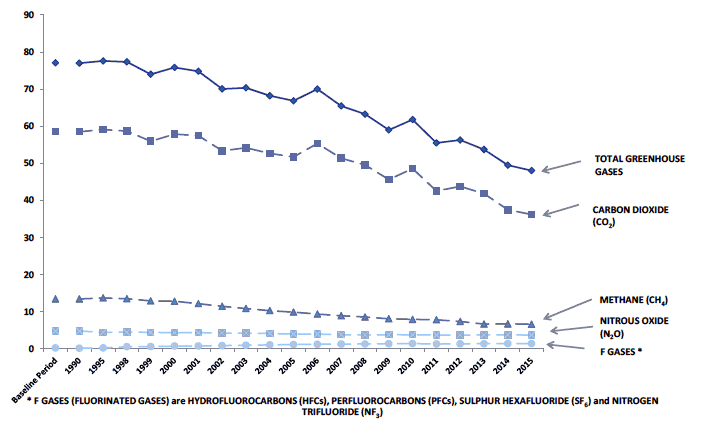
Main Points
- Carbon dioxide is by far the largest contributor to Scottish greenhouse gas emissions in all years (75.4 per cent of all emissions in 2015) and is the most volatile series of all gases - largely driven by changes in energy supply emissions and to a lesser extent, emissions from the residential and business and industrial process sectors.
- Methane is the second most common greenhouse gas in 2015 (13.9 per cent of all net emissions) followed by nitrous oxide (7.7 per cent) and F-gases making up the remainder (3.0 per cent).
- Methane has seen the largest percentage reduction from 1990 to 2015 (50.6 per cent), largely driven by a reduction in waste management emissions. There have also been percentage reductions for both carbon dioxide (38.1 per cent) and nitrous oxide (22.9 per cent). Emissions from fluorinated gases have shown a large increase from 1990 to 2015 and this increase is driven by the introduction of hydrofluourocarbons ( HFCs) from 1995 onwards. These HFCs replace chlorofluorocarbons ( CFCs) which were banned by the Montreal Protocol due to their impact on the ozone layer.
Charts B9 to B12 present results on individual gases broken down by main Scottish Government sectors over time. Table B3 contains figures on all greenhouse gas emissions across the time series. Chart B9 shows how carbon dioxide emissions have changed from 1990 to 2015.
Carbon Dioxide ( CO 2)
Chart B9. Carbon Dioxide ( CO 2) Emissions by Scottish Government Sector, 1990 to 2015. Values in MtCO 2e

Main Points
- Chart B9 shows that energy supply is a key source of carbon dioxide emissions in all years between 1990 and 2015. Transport (including international aviation and shipping) is the next most common source of carbon dioxide emissions in all years apart from 1990 and 2015. Transport is 1.3 MtCO 2e higher than energy supply emissions in 2015. In 2015 Transport became the highest source of emissions for the first time in the time series.
- Much of the decrease in carbon dioxide emissions between 1990 and 2015 has been driven by falls in the energy supply sector across the time period and in business and industrial processes between 1990 and 1995. Carbon dioxide emissions from the energy supply sector have been quite volatile, with the highest emissions occurring between 1995 and 2003, and a spike in 2006, related to a greater use of coal in that year.
- The agriculture and related land use sector has also seen a fall in net emissions of carbon dioxide - largely due to changes in land uses.
- Forestry has been a net sink of carbon dioxide consistently between 1990 and 2015.
Methane ( CH 4)
Chart B10. Methane ( CH 4) Emissions by Scottish Government Sector, 1990 to 2015. Values in MtCO 2e

Main Points
- Methane emissions from waste management have fallen from 13.5 MtCO 2e in 1990 to 6.7 MtCO 2e in 2015 (a 50.6 per cent reduction). This is due to the progressive introduction of landfill gas being captured and used for energy. There could also be other factors which contribute to this reduction, such as improvements in the standards of landfill and changes to the types of waste going to landfill.
- Methane emissions in the agriculture and related land use sector have fallen from 5.6 MtCO 2e in 1990 to 4.8 MtCO 2e in 2015 - a 15.0 per cent fall over this time period. This reduction is partly linked to a fall in livestock numbers.
- In the Energy Supply sector, methane emissions have fallen from 2.0 MtCO 2e in 1990 to 0.4 MtCO 2e in 2015, largely due to reductions in emissions from sources such as coal mining.
Nitrous Oxide ( N 2O)
Chart B11. Nitrous Oxide ( N 2O) Emissions by Scottish Government Sector, 1990 to 2015. Values in MtCO 2e
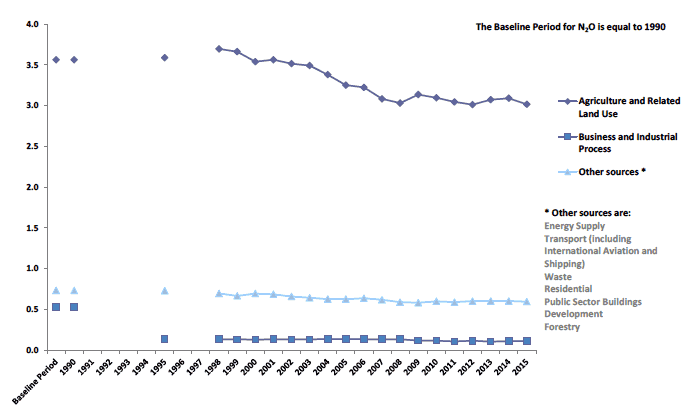
Main Points
- The Agriculture and related land use sector is by far the main contributor to emissions of nitrous oxide. These are largely produced by agricultural practices on soils, and to a lesser extent by animal manures. Emissions of nitrous oxide in this sector have fallen from 4.8 MtCO 2e in 1990 to 3.7 MtCO 2e in 2015.
- Emissions of nitrous oxide in the business and industrial process sector have fallen from 0.5 MtCO 2e in 1990 to 0.1 MtCO 2e in 2015.
Fluorinated gases (F-gases)
Chart B12. F-gas Emissions by Scottish Government Sector, 1990 to 2015. Values in MtCO 2e
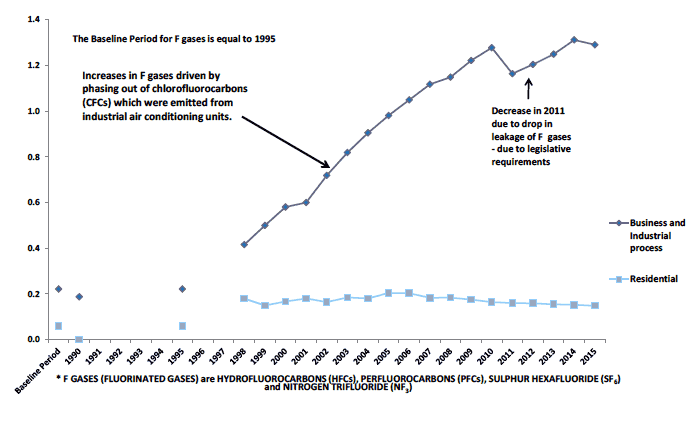
Note: the Baseline Year for F gases is 1995 rather than 1990
Main Points
- F gases are the most potent greenhouse gases with high global warming potentials but they are emitted in very small quantities. As a result, they contribute less to global warming than the other greenhouse gases in Scotland.
- There has been a sharp increase in F gas emissions from business and industrial processes between 1990 and 2015 (from 0.2 MtCO 2e in 1990 to 1.3 MtCO 2e in 2015). This is because F gases were introduced to replace chlorofluorocarbons ( CFCs), which were used in appliances such as industrial air conditioning units. CFCs were banned under the Montreal Protocol, as they were contributing to the depletion of the ozone layer.
- F gas emissions in the residential sector are caused by the use of aerosols and asthma inhalers, and represent between 0.15 and 0.20 MtCO 2e in the years between 1998 and 2015.
Table B2. Greenhouse Gas Emissions in Scotland by source sector: 1990 to 2015. Values in MtCO 2e
| Source Sector | Baseline Period | 1990 | 1995 | 1998 | 1999 | 2000 | 2001 | 2002 | 2003 | 2004 | 2005 | 2006 | 2007 | 2008 | 2009 | 2010 | 2011 | 2012 | 2013 | 2014 | 2015 | Change 1990 to 2015 | % change 1990 to 2015 |
|---|---|---|---|---|---|---|---|---|---|---|---|---|---|---|---|---|---|---|---|---|---|---|---|
| Total greenhouse gas emissions | 77.1 | 77.0 | 77.6 | 77.3 | 74.0 | 75.8 | 74.8 | 70.1 | 70.4 | 68.2 | 66.9 | 70.0 | 65.5 | 63.3 | 59.0 | 61.8 | 55.5 | 56.3 | 53.7 | 49.5 | 48.1 | -28.9 | -37.6% |
| Energy Supply | 22.7 | 22.7 | 26.8 | 25.8 | 23.4 | 26.3 | 25.6 | 23.5 | 23.7 | 21.9 | 20.8 | 24.8 | 21.4 | 20.1 | 18.7 | 20.8 | 17.0 | 17.5 | 16.0 | 13.9 | 12.2 | -10.5 | -46.4% |
| Transport (including International Aviation and Shipping) | 13.3 | 13.3 | 13.3 | 14.3 | 13.8 | 13.4 | 13.4 | 13.3 | 13.5 | 13.9 | 14.2 | 14.8 | 14.9 | 14.6 | 13.9 | 13.4 | 13.2 | 13.1 | 13.0 | 13.1 | 13.1 | -0.2 | -1.1% |
| Transport (excluding IA&S) | 10.7 | 10.7 | 10.7 | 11.1 | 11.2 | 11.0 | 11.0 | 11.3 | 11.4 | 11.5 | 11.6 | 11.8 | 12.0 | 11.5 | 11.0 | 10.9 | 10.6 | 10.7 | 10.6 | 10.6 | 10.8 | 0.0 | 0.4% |
| International Aviation and Shipping (IA&S) | 2.6 | 2.6 | 2.6 | 3.1 | 2.6 | 2.4 | 2.4 | 2.0 | 2.2 | 2.4 | 2.6 | 3.0 | 3.0 | 3.1 | 2.9 | 2.5 | 2.6 | 2.4 | 2.4 | 2.5 | 2.4 | -0.2 | -7.6% |
| Agriculture and Related Land Use | 14.6 | 14.6 | 14.8 | 14.8 | 14.5 | 14.4 | 13.9 | 13.6 | 13.8 | 13.4 | 13.0 | 12.6 | 12.3 | 11.8 | 11.9 | 11.7 | 11.3 | 11.1 | 11.2 | 11.0 | 10.8 | -3.8 | -25.8% |
| Business and Industrial process | 14.4 | 14.4 | 11.0 | 11.2 | 11.4 | 11.3 | 11.6 | 10.8 | 11.0 | 11.0 | 11.3 | 11.1 | 10.6 | 10.7 | 9.4 | 9.7 | 9.2 | 9.0 | 9.2 | 8.7 | 8.6 | -5.8 | -40.2% |
| Residential | 8.1 | 8.1 | 7.9 | 8.2 | 8.0 | 7.9 | 8.4 | 7.7 | 7.7 | 7.8 | 7.7 | 7.5 | 7.3 | 7.5 | 7.2 | 8.1 | 6.3 | 7.1 | 7.1 | 5.9 | 6.1 | -2.0 | -24.5% |
| Waste Management | 5.6 | 5.6 | 6.2 | 6.2 | 6.1 | 6.2 | 5.8 | 5.4 | 5.0 | 4.4 | 4.0 | 3.6 | 3.2 | 3.0 | 2.7 | 2.5 | 2.4 | 2.0 | 1.4 | 1.5 | 1.4 | -4.2 | -74.9% |
| Other sources | 3.6 | 3.6 | 3.7 | 3.6 | 3.6 | 3.5 | 3.5 | 3.2 | 3.2 | 3.3 | 3.3 | 3.1 | 3.0 | 3.2 | 3.0 | 3.1 | 3.0 | 3.0 | 3.0 | 2.8 | 2.8 | -0.8 | -22.7% |
| Development | 1.9 | 1.9 | 1.9 | 1.9 | 1.9 | 1.8 | 1.8 | 1.8 | 1.8 | 1.8 | 1.8 | 1.8 | 1.7 | 1.7 | 1.8 | 1.8 | 1.8 | 1.7 | 1.7 | 1.7 | 1.7 | -0.2 | -9.8% |
| Public Sector Buildings | 1.7 | 1.7 | 1.8 | 1.8 | 1.8 | 1.6 | 1.7 | 1.4 | 1.4 | 1.6 | 1.5 | 1.4 | 1.3 | 1.5 | 1.3 | 1.3 | 1.3 | 1.2 | 1.3 | 1.1 | 1.1 | -0.6 | -37.3% |
| Forestry | -5.3 | -5.3 | -6.1 | -6.7 | -6.9 | -7.1 | -7.4 | -7.6 | -7.5 | -7.4 | -7.5 | -7.4 | -7.4 | -7.7 | -7.8 | -7.5 | -7.0 | -6.5 | -7.2 | -7.3 | -7.0 | -1.7 | 32.7% |
Table B3. Scottish Greenhouse Gases, by gas, 1990 to 2015. Values in MtCO 2e
| Baseline Period | 1990 | 1995 | 1998 | 1999 | 2000 | 2001 | 2002 | 2003 | 2004 | 2005 | 2006 | 2007 | 2008 | 2009 | 2010 | 2011 | 2012 | 2013 | 2014 | 2015 | 1990 to 2015 (in MtCO 2e) | % Change from 1990 to 2015 | 2014 to 2015 (in MtCO 2e) | % Change from 2014 to 2015 | % Share of GHG 2015 | |
|---|---|---|---|---|---|---|---|---|---|---|---|---|---|---|---|---|---|---|---|---|---|---|---|---|---|---|
| Total Greenhouse Gases | 77.1 | 77.0 | 77.6 | 77.3 | 74.0 | 75.8 | 74.8 | 70.1 | 70.4 | 68.2 | 66.9 | 70.0 | 65.5 | 63.3 | 59.0 | 61.8 | 55.5 | 56.3 | 53.7 | 49.5 | 48.1 | -28.9 | -37.6% | -1.5 | -3.0% | 100.0% |
| Carbon dioxide ( CO 2) | 58.5 | 58.5 | 59.1 | 58.7 | 56.0 | 57.9 | 57.5 | 53.4 | 54.2 | 52.7 | 51.7 | 55.4 | 51.4 | 49.6 | 45.7 | 48.6 | 42.6 | 43.8 | 41.9 | 37.5 | 36.2 | -22.3 | -38.1% | -1.3 | -3.4% | 75.4% |
| Methane ( CH 4) | 13.5 | 13.5 | 13.7 | 13.5 | 12.9 | 12.8 | 12.2 | 11.5 | 10.9 | 10.3 | 9.9 | 9.4 | 8.9 | 8.6 | 8.1 | 8.0 | 7.8 | 7.4 | 6.7 | 6.7 | 6.7 | -6.8 | -50.6% | -0.1 | -1.4% | 13.9% |
| Nitrous oxide ( N 2O) | 4.8 | 4.8 | 4.5 | 4.5 | 4.5 | 4.4 | 4.4 | 4.3 | 4.3 | 4.1 | 4.0 | 4.0 | 3.8 | 3.8 | 3.8 | 3.8 | 3.7 | 3.7 | 3.8 | 3.8 | 3.7 | -1.1 | -22.9% | -0.1 | -2.1% | 7.7% |
| * F gases | 0.3 | 0.2 | 0.3 | 0.6 | 0.6 | 0.7 | 0.8 | 0.9 | 1.0 | 1.1 | 1.2 | 1.3 | 1.3 | 1.3 | 1.4 | 1.4 | 1.3 | 1.4 | 1.4 | 1.5 | 1.4 | 1.3 | 670.4% | 0.0 | -1.7% | 3.0% |
| of which HFCs | 0.1 | 0.0 | 0.1 | 0.4 | 0.4 | 0.5 | 0.6 | 0.7 | 0.8 | 0.9 | 1.0 | 1.1 | 1.2 | 1.2 | 1.3 | 1.3 | 1.2 | 1.2 | 1.3 | 1.3 | 1.3 | 1.3 | 60396.3% | 0.0 | 1.4% | 2.7% |
| PFCs | 0.1 | 0.1 | 0.1 | 0.1 | 0.2 | 0.2 | 0.1 | 0.1 | 0.1 | 0.1 | 0.1 | 0.1 | 0.1 | 0.1 | 0.1 | 0.1 | 0.1 | 0.1 | 0.1 | 0.1 | 0.1 | 0.0 | -12.9% | 0.0 | -15.8% | 0.2% |
| SF 6 | 0.0 | 0.0 | 0.0 | 0.0 | 0.1 | 0.1 | 0.1 | 0.1 | 0.1 | 0.1 | 0.1 | 0.0 | 0.0 | 0.0 | 0.0 | 0.0 | 0.0 | 0.0 | 0.0 | 0.0 | 0.0 | 0.0 | -31.8% | 0.0 | 2.0% | 0.1% |
| NF 3 | 0.0 | 0.0 | 0.0 | 0.0 | 0.0 | 0.0 | 0.0 | 0.0 | 0.0 | 0.0 | 0.0 | 0.0 | 0.0 | 0.0 | 0.0 | 0.0 | 0.0 | 0.0 | 0.0 | 0.0 | 0.0 | 0.0 | 50.9% | 0.0 | 10.0% | 0.0% |
* Note on F-gases:
HFCs are hydrofluorocarbons
PFCs are perfluorocarbons
SF 6 is sulphur hexafluoride
NF 3 is nitrogen trifluoride
Contact
There is a problem
Thanks for your feedback